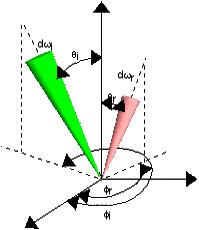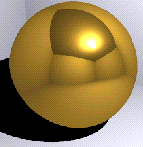
Computer Graphic Rendering of Material Surfaces

 |
Computer Graphic Rendering of Material Surfaces |
 |
|
Walk into a darkened room and turn on the lights. The gleam of furniture, the color and texture of carpets and curtains are instantly visible. A simple everyday act-but the science behind it is a complex and increasingly important part of materials design and manufacturing. Light from a light source hits a surface and part of it is scattered and transmitted to your eyes. The visual perception of an object- what we call its appearance arises from the interaction of incident light with the object's surface geometry or texture. Optical properties of the material (such as index of refraction or polarization) also play a very important role. Will there come a day when given the microstructural and optical properties of a material a computer program can create the image of a chair made with that material? Making that day a reality will depend on the outcome of research done today. For some years computer programs have produced images of scenes based on a simulation of scattering and reflection of light off one or more surfaces. In response to increasing demand for the use of rendering in design and manufacturing, the models used in these programs have undergone intense research in the computer graphics community. In particular, more physically realistic models are sought (i.e. models that more accurately depict the physics of light interaction). There has however been a lack of relevant optical measurements needed to complement the modelling. As part of the NIST competency project entitled "Measurement Science for Optical Reflectance and Scattering", Fern Hunt of MCSD 891 is coordinating the development of a computer rendering system that utilizes high quality optical measurements that will be used to render physically realistic and potentially photorealistic images. We are collaborating with Gary Meyer of Computer and Information Sciences Department at the University of Oregon and Gregory Ward Larson of SGI. They are working on the development of the rendering capability. To aid us in developing and assessing the optical measurement protocols we are also working with Michael Metzler of ISCIENCES, Inc. who has done extensive modelling and data analysis of optical measurements. The figures below are the very first results of this effort. Figures 1 through 4 are images of simulated objects coated with different materials coming from a database of optical measurements provided by the National Imaging and Mapping Agency. The rendering was performed by Gary Meyer and Peter Walker. Gregory Ward Larson of SGI rendered an automobile coated with a gray metallic paint. The optical measurements used to produce this image were performed by Maria Nadal, Yvonne Barnes, and Ambler Thompson of the Optical Technology Division 844. The results of Ward Larsons' work can be seen at NIST BRDF Measurements. |
|
|
Figure 1: Shows three rendered vases rendered from opitical mesurements taken from http://ciks.cbt.nist.gov/nef/nefhome.html NEFDS . Materials are lumber, paint, and aluminum (left to right).
Figure 3: Shows rendered painted vases using three different models. Scene depicts vases in a room with nine lights distributed along a ceiling in a 3x3 grid. The third vase depicts retro reflecting rough surface.
|
Figure 2: Five cubes. Top row use data from cement and paint. Lower row: wood, aluminum and concrete. (From left to right) Figure 4: Shows rendered vases in a room with nine lights as in Fig. 3. Materials modeled are concrete, paint, and camouflage (left to right).
|